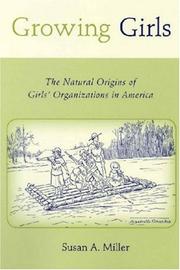| Listing 1 - 2 of 2 |
Sort by
|
Book
ISBN: 1496233670 9780803286863 0803286864 9781496233677 9781496233080 1496233085 Year: 2022 Publisher: Lincoln, Nebraska : University of Nebraska Press,
Abstract | Keywords | Export | Availability | Bookmark
 Loading...
Loading...Choose an application
- Reference Manager
- EndNote
- RefWorks (Direct export to RefWorks)
"Through the lens of America's first and most popular girls' organization, Jennifer Helgren traces the role and changing meaning of American girls' citizenship across critical intersections of gender, race, class, and disability in twentieth-century America"--
Girls --- Societies and clubs. --- Social conditions --- Social life and customs --- Camp Fire Girls. --- United States.

ISBN: 0813541565 9780813541563 9780813540634 0813540631 9780813540641 081354064X Year: 2007 Publisher: New Brunswick, N.J. : Rutgers University Press,
Abstract | Keywords | Export | Availability | Bookmark
 Loading...
Loading...Choose an application
- Reference Manager
- EndNote
- RefWorks (Direct export to RefWorks)
In the early years of the twentieth century, Americans began to recognize adolescence as a developmental phase distinct from both childhood and adulthood. This awareness, however, came fraught with anxiety about the debilitating effects of modern life on adolescents of both sexes. For boys, competitive sports as well as "primitive" outdoor activities offered by fledging organizations such as the Boy Scouts would enable them to combat the effeminacy of an overly civilized society. But for girls, the remedy wasn't quite so clear. Surprisingly, the "girl problem"?a crisis caused by the transition from a sheltered, family-centered Victorian childhood to modern adolescence where self-control and a strong democratic spirit were required of reliable citizens?was also solved by way of traditionally masculine, adventurous, outdoor activities, as practiced by the Girl Scouts, the Camp Fire Girls, and many other similar organizations. Susan A. Miller explores these girls' organizations that sprung up in the first half of the twentieth century from a socio-historical perspective, showing how the notions of uniform identity, civic duty, "primitive domesticity," and fitness shaped the formation of the modern girl.
Girls --- Children --- Females --- Young women --- History --- Camp Fire Girls --- Girl Scouts of the United States of America --- Campfire Girls --- Camp Fire, Inc. --- Girl Scouts of America --- Girl Scouts, Inc. --- Girl Scouts of the U.S.A. --- Girl Scouts of the USA --- Gërlskauty Ameriki --- Girls Scouts of the USA --- History.
| Listing 1 - 2 of 2 |
Sort by
|

 Search
Search Feedback
Feedback About UniCat
About UniCat  Help
Help News
News